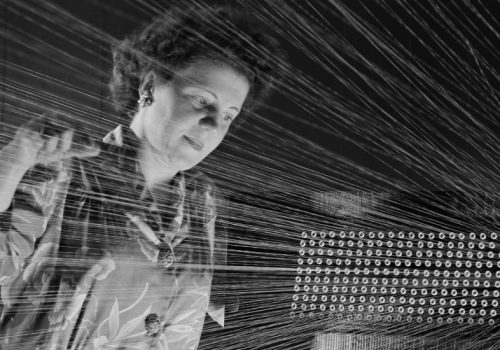FOTO/INDUSTRIA 2019, promoted and organised by the MAST Foundation, is focusing on the theme of the built environment and it’s featuring ten exhibitions in amazing venues around the city centre of Bologna plus one at MAST. Thanks to the works by well known names in the history of photography, like as André Kertész, Albert Renger-Patzsch, Luigi Ghirri and Lisetta Carmi as well as the ones by Edward Burtynsky, Jennifer Baichwal and Nicholas de Pencier, Armin Linke, David Claerbout, Matthieu Gafsou, Stephanie Syjuco, Delio Jasse and Yosuke Bandai, the central issue of this fourth Biennale of Photography on Industry and Work is explored from a number of different perspectives.
Indeed, the issue of the built environment is intimately connected with the nature of the human species, and the authors investigated it from its historic and philosophical roots to its scientific implications, documenting the human activities that gave rise to the “technosphere” on the Earth. The term “technosphere” – as Peter Haff, professor of geology and civil engineering at Duke University, called it in 2013 – refers to all kind of structures built by man to survive and live on the planet.
“This artificial layer has been monitored over the last two centuries thanks to a fundamental medium for shaping and constantly updating the collective imagination: photography is at once an indispensable research tool and a product of the inextinguishable human need to change the world and see it afresh”, the artistic director Francesco Zanot says. “The vast impact of the intervention by humans on the environment is made evident by the diversity of subjects and places represented in the artists’ images”, he adds.
According to the Major of Bologna, Virginio Merola, “we can affect the present for a better future and we can do it in a sustainable manner. In this respect, photography has a major role in promoting awareness and talking about this issue”
“It’s such a global theme”, Francesco Zanot says, “it has been regarded as a system of sampling. Thus, for instance, you can find the photos by Albert Renger-Patzsch, portraying landscapes of the Ruhr district, kind of a industry archetype in the 30s, as well as works about the man-machine relationship by André Kertész (best known for his images of Paris street life) commissioned by companies that intended to enhance their image by means of elegant publications. The exhibition dedicated to Lisetta Carmi deals with her committed social reportage, focused on the factories and the port of Genoa and its deep yet contradictory relationship with the city, while the ones by Luigi Ghirri, though commissioned, were felt like invaluable opportunities to experiment, to test himself.
Armin Linke investigates both underwater researches and the effects of climate change according to a social, scientific and ethnographic perspective. David Claerbout and Stephanie Syjuco seem to have a conversation with time: the first one representing in Olympia, a computer-generated replica of the Olympic stadium in Berlin, the progressive decaying of the stadium itself, the other by referring to a movie shot shortly before the earthquake that destroyed San Francisco in 1906. Délio Jasse studies and represents Luanda, the capital city of Angola, investigating its fast growing and the simultaneous loss of its own “shape”. The images by Matthieu Gafsou, represent the issue of transhumanism and portrays the dissolution of technologies and people, the erasure of former ontological boundaries. Then Yosuke Bandaj, with a project consisting of 70 images. It began when the artist collected a series of objects lying in the street (from fragments of plastic to rubbish) in order to create minimal, fragile sculptures. He then scannerized them, transforming them in something different, like totems”.
L’Oeil already dealt with Anthropocene, at MAST. This multimedia show documents the impact of human beings on the planet through the photographs by Edward Burtynsky, the films by Jennifer Baichwal and Nicholas De Pencier and a series of augmented reality installations.
Francesco Zanot is the curator FOTO/INDUSTRIA 2019, with its ten exhibitions in the city centre and the one at MAST, curated by Urs Stahel.
FOTO/INDUSTRIA is the world’s first Biennial devoted to photography relating to industry and work. It is produced and promoted by the MAST (Manifattura di Arti, Sperimentazione e Tecnologia) Foundation, an international non-profit organisation, associated with the industrial group Coesia, and conceived as a bridge between the company and the community. FOTO/INDUSTRIA was created in 2013, with François Hèbel as artistic director for the first three editions, with the aim of sharing the Foundation’s cultural mission with the city of Bologna.
Paola Sammartano
Paola Sammartano is a journalist, specialized in arts and photography, based in Milan
FOTO/INDUSTRIA 2019
IV BIENNIAL OF PHOTOGRAPHY ON INDUSTRY AND WORK
Tecnosfera/ Technosphere: Humankind and the Built Environment
From October 24 to November 24, 2019
Biblioteca Universitaria di Bologna – Armin Linke – Prospecting Ocean
Fondazione Cassa di Risparmio in Bologna – Casa Saraceni – André Kertész – Tires / Viscose
Fondazione del Monte di Bologna e di Ravenna, Palazzo Paltroni – Délio Jasse – Arquivo Urbano
Genus Bononiae, Santa Maria della Vita – Lisetta Carmi – Porto di Genova
Mambo, Museo d’Arte Moderna di Bologna – Stephanie Syjuco – Spectral City
MAST. – Anthropocene – Edward Burtynsky, Jennifer Baichwal, Nicholas De Pencier (open until January 05, 2020)
Museo Internazionale e Biblioteca della Musica – Yosuke Bandai – A Certain Collector B
Palazzo Bentivoglio – Luigi Ghirri – Prospettive industriali
Pinacoteca Nazionale di Bologna, Palazzo Pepoli Campogrande – Matthieu Gafsou – H+
Pinacoteca Nazionale di Bologna, Palazzo Sant’ignazio – Albert Renger-Patzsch – Paesaggi della Ruhr
Spazio Carbonesi – David Claerbout – Olympia
Bologna
















